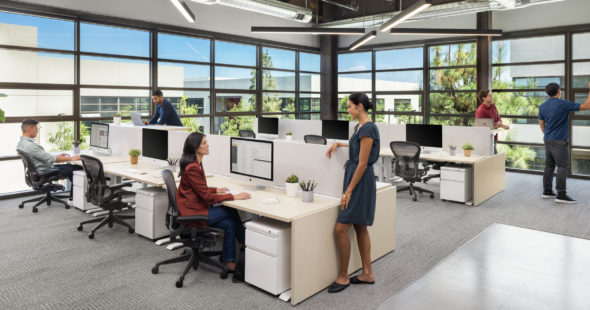When it comes to office design, the smallest details can make a big impact on health and wellness. Posture, productivity, stress, and muscle pain are just a few factors that are drastically impacted by office environments. It is estimated that up to 54 percent of Americans who suffer from lower back pain spend most of their day sitting at a desk. As of 2015, injuries due to lower back pain alone cost employers approximately $34,600 in medical and disability claims. In addition to being costly and physically harmful, workplace injury can also lead to absenteeism and depression, both key contributors to lack of productivity in the workplace.
So, how do we create office environments that help us work smart and live well? The answer is ergonomics, or the “science of fitting a workplace to the user’s needs to increase efficiency and productivity and reduce discomfort.” Whether it’s a desk, a monitor, the lighting or the thermostat, they key to designing an ergonomically friendly environment is adjustability. Each employee is unique, requiring a work environment specialized for his or her body shape and personal preferences. Accounting for these differences will not only promote a more productive work environment, it will also engrain health and wellness best practices into your company culture.
Before we jump into how to make your office ergonomic, let’s go over some risk factors. Holding a certain posture for an extended period of time can restrict blood flow, compress nerves and damage muscles, especially when the position is awkward or strained. Over time, unnatural postures can become habit, not only leading to physical stress, but emotional stress as well. Alternatively, a study performed by UpRight and Ernst & Young Israel indicated that good posture in the workplace can boost productivity, increase confidence levels, strengthen core muscles, and decrease back pain.
One of the main ways employers can strengthen posture is seating. As spine length and shape vary according to a person’s height and body type, chairs should adjust to provide optimal lumbar support. To reduce stress on the spine, padded, adjustable armrests should be used throughout the workday. Seats should be able to recline and move with the body to stimulate blood flow and relieve back pressure.
Ergonomics is also about promoting activity in the workplace. While seating is important, furniture that encourages standing and movement should also be considered. Sitting in the same position for an extended period of time has been linked to an array of health issues, including obesity and diabetes. To ensure your workforce stays happy and healthy, consider incorporating standing desks. Studies have shown that replacing sitting with standing for two hours may improve blood sugar and cholesterol levels. In addition to a more physically healthy lifestyle, daily activity during the workday has also been proven to boost mental health. The Stand Up to Work study, funded by the American Society of Interior Designers Foundation, revealed that a 15 percent average decrease in workday sitting promotes better coworker communication, more efficiency and higher job satisfaction.
Contrary to popular belief, a colder work environment is not conducive to higher levels of alertness and productivity. In fact, colder temperatures can negatively affect dexterity, causing more strain on the hands when performing manual tasks, like typing. Studies have shown that women, especially, were highly productive when offices were kept at 77° F. However, when the temperature dropped to 68° F, error rates among the female employees rose by 25 percent. Additionally, offices that favor natural light over fluorescent lighting boast a more alert and productive workforce.
Many employees spend their workday in front of a computer, so it’s no surprise that monitor placement plays an integral role in ergonomic design. Monitors should be at eye level and chairs should be the same height as the keyboard. Incorrectly using of the keyboard and mouse can increase the likelihood of musculoskeletal disorders by as much as 81 percent, so be sure to consider specially designed ergonomic options for your office space. Avoid eyestrain by placing the monitor at least an arm’s length away from you. Monitors should also be positioned away from light sources to minimize glare.
It’s no surprise that maintaining an ergonomic environment is crucial in promoting overall workplace wellness. Supporting both physical and mental health, incorporating ergonomic best practices into office design is a tried and true way to ensure a well-rounded lifestyle.
If you’re interested in supplementing your daily schedule with exciting fitness classes, wellness tips and more, download the KINETIC App for iPhone or Android.





